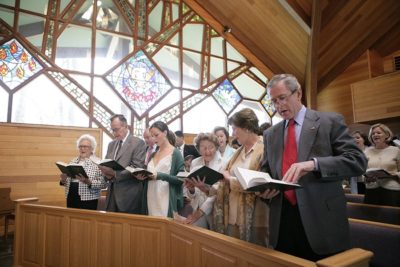One Small Step in the Battle for Religious Pluralism in America

President George W. Bush, joined by, from left, First Lady Barbara Bush, Former President George H. W. Bush, Barbara Bush, Jenna Welch and Mrs. Laura Bush, sings a hymn Sunday, April 16, 2006, during Easter Service at Evergreen Chapel at Camp David in Thurmont, Md. Photo by Eric Draper, Courtesy of the George W. Bush Presidential Library and Museum
Rabbi A. James Rudin (he/him) is the former head of the American Jewish Committee’s Department of Interreligious Affairs and author of seven books, most recently, Pillar of Fire: A Biography of Stephen S. Wise. He served as a U.S. Air Force chaplain in Japan and Korea.
On April 21, 1991, my wife Marcia and I were among the 150 guests President George H. W. Bush invited to the formal dedication service of the newly constructed Interfaith Chapel at Camp David, the presidential retreat.
Two years earlier, I was the only Jewish member of a 15-person committee charged with raising funds to build the chapel and determine its design.
The debate that ensued over the proposed images on the chapel’s 8 stained-glass windows brought to the surface the tension between those who see America as a Christian nation and those who, like me, believe that the Constitution guarantees the freedom of religion and conscience for all its citizens.
Despite the chapel’s official interfaith name and announced purpose, some members insisted that our mission was to create a Christian church.
What I call “The Battle of Camp David” began when the highly skilled, deeply religious Christian émigré artist, Rudolph Sandon, and his wife, Helen, laid out the initial sketches of their window designs. Six of the 8 contained the denominational logos of major Protestant bodies, including the Presbyterian Church, the United Methodist Church, the United Church of Christ, and the Episcopal Church. The seventh featured a Christian cross representing Roman Catholicism, and the eighth combined symbols of Judaism, Islam, and Hinduism.
The Christian committee members reacted with enthusiasm to the design proposal. I was disheartened. When my turn came to speak, I made it clear that my objections to the window designs were not aimed at the Sandons or their artistic skills. What troubled me was the whiff of Christian triumphalism on display. I questioned why Jews, Muslims, and Hindus were lumped together into one window. What about Buddhists, Shintoists, America’s indigenous peoples, and other excluded faith communities?
I also expressed my conviction that the chapel should contain no permanently displayed symbols or representations of any particular faith, such as a crucifix or menorah. I knew from my experience as an Air Force chaplain in Japan and Korea that in a spirit of mutual respect and understanding, the specific objects required for liturgy and religious ritual were brought into the chapel area for temporary use during a Christian or Jewish worship service and then returned to storage areas.
Since this arrangement worked well in “ordinary” USAF chapels overseas, I felt it was even more important that such procedures be followed at the presidential retreat chapel.
I continued my litany of objections by pointing out that every religion known to the human family was represented in the United States, and that extraordinary demographical reality will not change. I added that because leaders from other nations, many of them not Christians, are frequently guests at Camp David, it was imperative their unique religious sensibilities be respected.
I reminded my chapel committee colleagues that Israeli Prime Minister Menachem Begin, an Orthodox Jew, and Egyptian President Anwar Sadat, a devout Muslim, had hammered out a peace agreement between their two countries at Camp David in 1978.
Finally, I urged that the original plans for the windows be scrapped and redesigned to express universal religious values common to all peoples.
At first, the other committee members were reluctant to abandon the Sandons’ original designs. But after a series of committee meetings that took place over several months, the tide slowly turned.
The Sandons came back to us with radically revised plans, featuring visual representations of the sea and an anchor, a mountain, a globe, an open book, a tree of knowledge, a sheaf of wheat, seven flames, a dove, and a lamp with a flame. We approved the more inclusive design unanimously. Some members thanked me and admitted that it was their first encounter with an assertive advocate of religious pluralism.
The brochure describing the Camp David Chapel reads in part: “All symbols were selected and designed to be open to various understandings by persons of differing faith traditions... For example, the mountains may be seen as the land God created or Mount Sinai, or Mount Moriah, or Mount Calvary.”
The Battle of Camp David was a small step in the ongoing battle for religious freedom in the United States. Let us not sit idly by when that freedom is threatened or denied.


